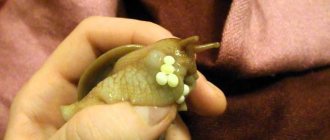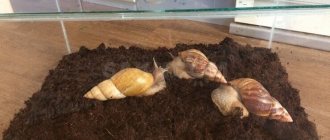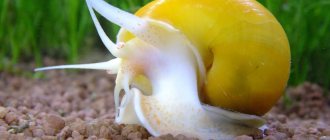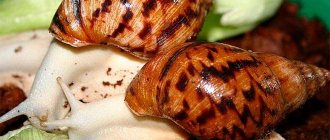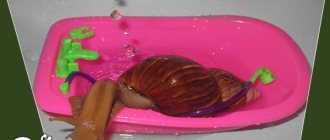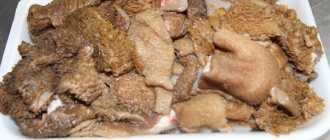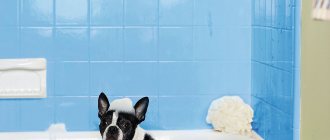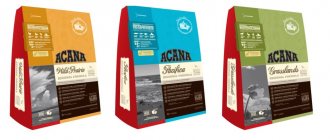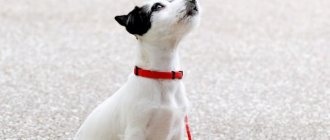Home » Useful Information
The African snail Achatina is an exotic pet. With proper care, the mollusk grows to enormous sizes. It is important for breeders to know what to feed Achatina at home in order to provide them with all the nutrients necessary for life and growth.
- 1.1 What can you feed Achatina
1.1.1 Video: greens in the diet of Achatina
- 1.1.2 Video: feeding Achatina, nutritional supplements
- 2 Achatina diet at home
- 3 Vitamins and minerals
- 4 Sources of calcium in the snail's diet
- 5 How often should you water shellfish?
- 6 What to feed newborns and small snails
6.1 Video: reproduction, laying, how to care for cubs
Calcium in nature
Calcium occurs in nature only in the form of compounds, such as limestone (calcium carbonate), gypsum (calcium sulfate) and dolomite. Snails need feeding containing calcium carbonate with the chemical formula CaCO3. Calcium carbonate is the main component of limestone, marble, chalk, and is also part of egg shells.
In their natural environment, snails detect calcium and other food through their respiratory tract (olfactory cells).
Calcareous soils, dead animal bones, empty shellfish shells, and some plants are sources of calcium.
Cuttlefish shell (sepia)
The cuttlefish shell is also a high calcium product, it contains up to 35% of this element.
This is nothing more than the skeleton of a cuttlefish. It is most often sold as a mineral supplement for parrots. The cost varies - from 60 to 120 rubles for 1 shell, depending on the point of sale.
The shell can be placed in the terrarium whole or in large pieces; the snails will gnaw it. My Chamomile, when she was little, loved to chew it in large pieces, but over time she stopped liking this product and practically stopped chewing it. Therefore, now I add sepia either in crushed form or in small pieces, so as not to simply transfer the product. In conditions of high humidity in the terrarium, the shell softens, darkens, and the snail completely refuses to eat it. She prefers only white, fresh and crisp sepia.
Cuttlefish shell
It is necessary to check the shell for saltiness before giving it to the snail. Cuttlefish is a marine animal, so its skeleton has a certain salinity due to salty sea water. If the shell is salty, it can be washed in cold running water and then dried.
When purchasing sepia, pay attention to its naturalness. Sometimes sepia for parrots is sold with flavors or dyes, which is absolutely not suitable for snails. Buy natural white shell without additives.
Why does a snail need calcium?
Snail shells are mainly composed of calcium carbonate CaCO3 and a binding protein (conchiolin). As the mollusks grow, they secrete a substance that increases the size and thickness of the shell. This substance is secreted by glands on the skin fold - the mantle, and it consists mainly of calcium carbonate. Essentially, snails consume calcium, process it and grow new coils, which is how shells grow. That is why young individuals and mollusks with damaged shells need increased amounts of this substance.
Calcium is also necessary for the formation of healthy egg clutches.
Snails receive this useful substance not only from food, but also absorb it through the sole of their feet when crawling.
Calcium deficiency - what can happen?
If there is a lack of calcium for snails, many problems can arise:
- Stunting of growth;
- Weak regeneration, that is, any crack on the sink will take longer to heal;
- Gnaws itself and its neighbors, it can gnaw on a neighbor's shell or its own;
- Difficulties with laying eggs, the health of the pregnant female weakens.
In order for the mollusk to be beautiful and healthy, it is necessary to provide its diet with all useful substances.
What can be used
To prevent your pets from experiencing any of the above, it is necessary to provide them with a high-quality source of calcium.
Suitable substances contain approximately 75% CaCO3.
Other substances, for example, MgCO3, vitamins and minerals - iron, folic acid, phosphorus, will not harm shellfish, but copper should be avoided, since it is very toxic even in small quantities.
Sources of calcium for snails can be:
- Shell rock (limestone);
- dolomite flour;
- natural chalk;
- sepia (cuttlefish shell);
- egg shells;
- shells of other mollusks.
Almost all of these products can be purchased at pet stores. When purchasing, be sure to pay attention to the composition, which should not contain salt.
Some shellfish keepers use tricalcium phosphate. Only this supplement must be fed in a mixture with another source of calcium from those listed above. It is not recommended to feed it in its pure form.
Sepia and natural chalk do not need to be crushed, but simply placed in a terrarium; snails can easily gnaw them. But other types need to be ground to a powder, mixed in any proportions and fed to snails or given separately.
If your adult snails periodically lay eggs, and you no longer know what to do with them, then do not rush to throw them away. Dried snail eggs are an excellent calcium supplement for newborn snails and weakened individuals.
The little ones are known to eat their shells after birth. And after 2-3 days, they can already be offered the calcium mixture either by sprinkling it on plant food or by mixing it with water and smearing it on the walls of the terrarium.
Sometimes the question arises: can snails take calcium gluconate, calcide and other similar drugs? Some breeders feed human drugs to their pets. But you shouldn't do this. Let's justify:
- these drugs are intended for humans;
- they have side effects even for the human body;
- it is not a natural source of calcium;
- their effect on snails has not been studied;
- contain very little calcium, only 9.5%;
- the composition may contain a substance dangerous to the snail.
Do not experiment on your pets; snails absorb natural calcium well, and they do not need tablets.
What do snails like to eat?
Lettuce leaves are often used as edible soil for newborn and small Achatina snails. And also as an edible plate.
Try not to feed your snails cucumbers every day, as they are high in water and low in nutrients.
Alternate zucchini with cucumbers. You can use them as an edible container for treats and cakes.
Try not to feed your snails spinach every day. Spinach interferes with the complete absorption of calcium. As a result, the shell of the mollusk will become fragile and soft.
Cabbage is used in the same way as lettuce. As a nutritious bedding and plate.
Carrots contain many useful vitamins and microelements. I read on many sites that if you feed snails with carrots, their shells will become bright and colorful. I didn't notice this.
Snails love bananas and will only eat them, but do not give bananas to small snails. Toddlers may become stuck in the viscous pulp and suffocate.
It is believed that bell peppers rot quickly in the warm, humid environment of a terrarium. Promotes the formation of mold and annoying midges.
Mushrooms are a protein of plant origin. Therefore, on the days when you give mushrooms, do not give gammarus or dried daphnia.
Try not to feed peaches to snails every day, as their mucus becomes very watery.
Pick leaves and grass away from roads and cars. Before feeding, wash thoroughly with warm water to remove dust and various germs.
In addition to vegetables and fruits, domestic Achatina snails need calcium. It helps the formation and growth of all internal organs and the snail shell.
How much calcium does a snail need?
How can a snail be given calcium and how much does it need? In the snail's terrarium, sepia, ground eggshells or chalk, whatever you offer your pet, should always be freely available.
You can sprinkle crushed calcium on your daily plant food or mix the calcium mixture into the soil.
Feed chalk or dolomite flour is also used to neutralize the acid-base environment of snail litter.
But sprinkling calcium on fruits and vegetables that contain large amounts of acid is not recommended. It is better to feed such products separately.
Sometimes inexperienced snail keepers are interested in the question: is it possible to overfeed the snail with calcium? No, the snail will eat as much as it needs.
The snail's diet can be varied with other foods containing calcium in small quantities. This:
- Vegetables – cabbage, broccoli, watercress, spinach. They are fed fresh, except for cabbage, which it is advisable to first scald with boiling water and cool.
- Seeds - sesame, sunflower seeds, mustard and rapeseed, poppy seeds, buckwheat, rice and nuts (except peanuts). These products are not often offered to pets in ground form as a treat for their main meal. It is necessary to grind before feeding; it is not worth storing for future use.
- Bone, fish, meat and bone meal, feed for poultry - they are fed infrequently and in small quantities, once a week will be enough. After feeding, remove any leftovers immediately. Before feeding your pets such food, study the composition and expiration dates.
- Milk – occasionally, as a treat.
In order for calcium to be well absorbed, it is necessary to introduce the following foods containing vitamin D into the snail’s diet:
- Green parts of dandelion, nettle, alfalfa, woodlice and other plants;
- Mushrooms;
- Sea fish;
- Milk.
Don't forget about other vitamins that are found in various fruits, vegetables and herbs. Provide your pet with a varied and nutritious diet, and the snail will not have problems with its shell. For a list of what to feed your snail, see here.
Prohibited foods in the diet
The following list will clearly demonstrate what you should not feed Achatina snails. These products are dangerous to the health and life of pets, and most importantly, they can lead to their death or painful, protracted illnesses. Prohibited products include:
- Salt is the white death of the Achatina snail! A few grains of salt can kill 2-3 babies and an adult.
- Food from the people's table! Domestic snails should not eat anything fried, spicy, pickled, sweet or smoked. It is forbidden to feed even on trial, even as an experiment.
- Pasta and any flour products will lead to death. The snail will not be able to digest such heavy food.
- It is not recommended to feed Achatina eggs, even boiled, due to salmonellosis. However, some breeders pamper their pets with this valuable protein product.
- Bitter, hot and sour vegetables are prohibited - onions, garlic, radishes, sorrel, wormwood, tomato tops.
- Citrus fruits are not recommended due to their high acid content.
- It is not advisable to feed potatoes even when boiled!
- Semolina swells greatly and absorbs water, making it difficult for weak, delicate Achatina to digest.
From the two lists given, we can conclude what can and cannot be fed to Achatina snails and how to create a complete daily diet. But it will not be complete without mineral supplements that will provide the delicate Achatina with vital microelements.
Calcium for Achatina snails
Many owners of exotic pets are interested in which calcium to choose for Achatina snails. The most popular and affordable option is eggshells. It is first ground into powder in a coffee grinder, and then sprinkled on plant foods or included in the calcium mixture. The shells of both boiled and raw eggs are used.
Sepia or cuttlefish shell is also actively used by snail breeders. Achatina really likes this source of calcium, and they happily gnaw on it. Only cuttlefish shell is not very cheap and cannot be found everywhere. In addition, it is necessary to pay attention that the sepia is not salty, and desalinate it if necessary. Read more about sepia here.
You can also use shell rock or natural chalk. Only pure chalk, without impurities or additives, is allowed to be fed to snails. If you want to offer bird stone to your shellfish, then first study the composition. And, if it does not contain substances harmful to snails, then feel free to feed your pets. But it’s not a fact that they will attack chalk after eggshells or sepia.
What to feed newborns and small snails
For the first few days after hatching, Achatina snails feed on the shells of their eggs and do not require additional attention. Grown-up babies eat the same things as adults. But to make it easier for them to eat, food is grated or chopped with a knife. It is impossible to feed small Achatina with pureed food: they can suffocate in the loose mass.
Grown-up snails are fed the same foods as adults.
It is important to gradually introduce a variety of delicacies into the diet of small snails in order to form correct eating habits and avoid pathological addiction to a particular product. It's best to start with greens, carrots and apples. The kids' favorite treat is cucumber.
It is necessary to add calcium supplements to food: the need of small Achatina for calcium during the period of intensive growth and shell formation is colossal.
Video: reproduction, laying, how to care for cubs
Calcium for snails in an aquarium
Aquarium snails also need calcium. Unlike their land-based counterparts, aquarium snails absorb this beneficial substance from water and food. Therefore, the pH of the water in the aquarium should not be lower than 7, but preferably higher. If the water is too soft, you can increase the hardness by adding:
- crushed marble;
- limestone;
- dolomite;
- sea shells;
- ground eggshells;
- special preparations to increase pH and calcium concentration.
But before increasing the pH, make sure that the rest of the inhabitants of your aquarium can withstand this concentration. And do not increase the pH level too sharply (maximum 0.5/day).
Regular water changes are also important.
Remember that vitamin D is necessary for calcium absorption, so place the aquarium in such a way that your pets have enough light.
If you have an internal filter installed, you can add coral chips, chalk or another source of calcium to it. Under the pressure of water, calcium will be actively washed out of the coral and into the aquarium.
You can also simply place a cuttlefish shell, chalk or eggshell in the aquarium.
For those who want to have aquarium snails with beautiful and intact shells, it is necessary to offer calcium-containing products to their pets. You can feed the shellfish with food for shrimp or turtles, pre-scalded cabbage leaves or specially prepared cottage cheese.
Making cottage cheese for snails is very simple. To do this you will need 0.5 liters of milk and 1 ampoule of calcium chloride (10 mlg). Pour calcium chloride into milk and bring to a boil. Pour the curdled milk into a sieve or colander. When the whey has drained, squeeze it out a little more, put the cooled cottage cheese in a container with a lid and place it in the refrigerator. Cottage cheese for snails is ready. You can break off small pieces and feed them to your pets. Do not feed a lot of cottage cheese at a time, and remove any leftovers immediately, since such food quickly spoils the water in the aquarium.
It is necessary to feed snails with such products 2-3 times a week if the shells of the mollusks have already begun to deteriorate. After the pets' condition improves, feeding 2 times a month will be sufficient if the water in the aquarium is hard enough.
We would like to disappoint the owners of aquarium snails. Once a mollusk shell has begun to deteriorate, it will never recover.
Is it possible to give meat to pet snails?
The claim that all snails are natural vegetarians is not entirely true. Sometimes the owners of Achatina and Arkhachatina feed their pets well-cooked (without salt) meat. Alternatively, you can use chicken cooked in the same way. However, we should not forget that animal food is quite heavy and is not so difficult to digest. For this reason, it is better to avoid meat food due to its harmfulness to snails. Even if it is rarely used, it is better not to give it. In addition, snails raised on meat feed can exhibit aggressive and predatory behavior, which can result in the snail attacking its smaller relatives.
Snails are fed with fruits.
Bottom line
Calcium for snails is not only one of the most important components of their diet. With the help of this substance, snails build up their external skeleton - the shell, which contains all the internal organs. A strong shell, in turn, allows you to hide in case of danger or wait out unfavorable conditions. From all this we can conclude that calcium is vital for the snail and should be freely available to the mollusk. Feed your pets correctly, and they will delight you throughout their short lives. Read here what you can feed your pet snails.
https://youtu.be/L6sZy_tCSEg
4.5 / 5 ( 2 voices)
Principles of organizing proper nutrition for African Achatina
There are basic principles of snail nutrition that apply to all species:
- Achatina’s daily diet should include a variety of plants;
- Important animal proteins supplement the snails' main diet;
- The third mandatory component of the diet of Achatina snails is mineral feeding.
The nutrition of African Achatina snails at home is based on these three basic principles. A constant lack of one of the components will lead to illness in the tender snail and its possible death.
The African snail Achatina in its natural habitat prefers leaves and grass, tree bark and juicy tropical fruits. It seems that Achatina are real gourmets, they can eat fresh herbs and immediately snack on half-rotten berries. Certain species of Achatina consider fallen rotting wood a real delicacy and can eat it entirely in a huge colony without leaving a trace. As you know, snails have many teeth, they are quite voracious, often attack large plantations of cultivated plants and in a short time cause irreparable damage to farming.
On a note! Any human food, bread and other flour products are strictly contraindicated for domestic snails.
Under no circumstances should cut up newspapers be placed in the aquarium of domestic snails as bedding. Eating paper, especially with printed font, will lead to the death of pets. And, most importantly, the tender Achatina is very afraid of grains of salt. They corrode their thin skin and burn their insides. Half a teaspoon of salt can kill an entire herd of defenseless snails!
It is not advisable to include citrus fruits and other sour fruits in the daily diet of Achatina snails. Any strong acids negatively affect the digestion and vital functions of Achatina. These foods are not strictly prohibited; they can be given in limited quantities and the reaction and condition of the snails can be monitored.
Sea shell
Seashell is sold either separately in crushed form as feed for farm animals, or in mixtures for turtles. Preference should be given to shell rock without additional additives. That is, the composition must contain 100% shell. It contains up to 40% calcium.
This product is not the most convenient to use, since the shell, although sold crushed, is not small enough for the snail. It needs to be ground into dust using a coffee grinder. The shell itself is quite hard, so you need a powerful grinder. Also pay attention to the fact that the shell rock is clean and does not contain sand and stones, which is also common. If the shell is dirty, it should be washed and dried thoroughly before crushing.
Sea shell - not yet crushed, and feed chalk
After grinding, the shell is crumbly, but quite dense and heavy. I also give it as part of a complex mixture.
The cost of a seashell is also affordable - 20-40 rubles per 1 kg. It lasts a very long time and also has an unlimited shelf life.
Cucumber miracle cocktail.
Many snails love cucumbers, so you can prepare a cucumber cocktail for them.
- juice of 1 cucumber;
- a spoonful of calcium mixture;
- spoon of grain mixture;
- ground dried herbs and leaves.
Mix all the ingredients and place the miracle cocktail in a bowl or on lettuce leaves. Snails really like this combination of products and they grow quickly and well.
Eggshell
The most natural source of calcium. Plus it's free. Those who breed snails give the snails the shells of the eggs from which they hatched. Chicken and quail egg shells are also suitable for feeding adult snails.
Any egg shell contains approximately 35% calcium, which is quite a lot.
Please note that only raw egg shells should be used. The shells of boiled eggs will contain half or even less amount of calcium. In addition, there are doubts about the digestibility of the heat-treated product. During cooking, most of the valuable mineral goes into the water.
Quail egg shell
Before harvesting, the shells must be thoroughly washed, since the shells of chicken eggs may contain salmonella. Free the inside of the shell from films. Dry the shells and grind in a coffee grinder. Quail egg shells, as a rule, do not contain salmonella, but in any case, they also need to be washed. By the way, it was the quail shell that my pet really liked.
Do not give the snails unground egg shells - such shells will not be absorbed by the mollusk’s body. Moreover, the sharp edges of the shell can injure a delicate animal, including when passing through the snail’s digestive tract.
I can’t give the exact shelf life of this product, but I found information that the shells can be stored for about a year, although this is not accurate information. I usually collect shells in the summer when poultry have a richer diet. It is logical that such a shell will have a richer mineral composition.
What can your pet treat?
Just like humans, snails have their own nutritional preferences or dislikes. But, in general, they are almost omnivores. It is very good if snails eat the following at home:
- Greenery.
It must be picked as far away from the city or roads as possible, and washed thoroughly before giving it to the snail. Most of all, mollusks love lettuce leaves, which can be given whole without tearing, as well as leaves of dandelion, plantain, clover, alfalfa, and nettle. They will not refuse the inflorescences of fruit trees, meadow flowers, or sprouted oats.
- Fruits, berries.
The favorite fruit of many snails is apples. With appetite they eat grapes (you can’t give them very often), figs, pineapple, pear, strawberries, wild strawberries, cherries, apricots, peach, nectarines, bananas, plums, mangoes, avocados, blueberries, cherries, cherry plums, kiwis, papaya, watermelon (necessarily seedless!).
- Vegetables.
Land snails happily eat fresh cucumbers, zucchini, tomatoes, melons, pumpkin, spinach, and sweet peppers. Some individuals eat carrots and cabbage (cauliflower, Chinese cabbage, broccoli). But what they don’t really like is potatoes, unless they are boiled.
- Legumes, grains.
You can give beans, beans, peas, corn.
To the list of what snails eat, you can add champignons, softened bread, hard-boiled eggs, cottage cheese, baby food, fish food (gammarus, daphnia), dry rolled oats flakes, bran.
Attention: one of the conditions for a balanced diet is not to provide snails with their favorite treat too often, otherwise there is a risk of the snail refusing other foods.
